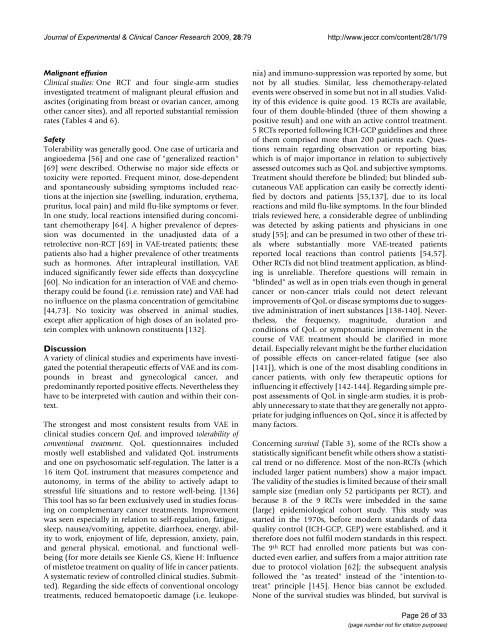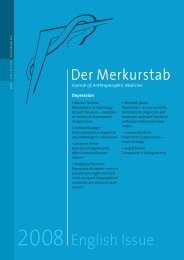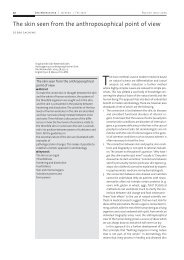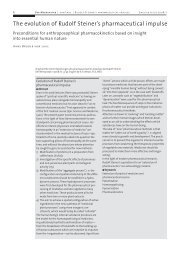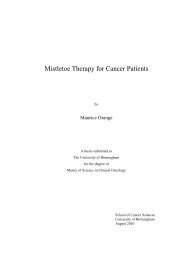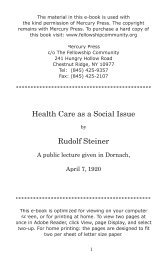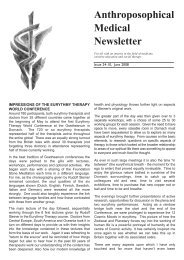Kienle Breast Cancer.pdf - AnthroMed Library
Kienle Breast Cancer.pdf - AnthroMed Library
Kienle Breast Cancer.pdf - AnthroMed Library
Create successful ePaper yourself
Turn your PDF publications into a flip-book with our unique Google optimized e-Paper software.
Malignant effusion<br />
Clinical studies: One RCT and four single-arm studies<br />
investigated treatment of malignant pleural effusion and<br />
ascites (originating from breast or ovarian cancer, among<br />
other cancer sites), and all reported substantial remission<br />
rates (Tables 4 and 6).<br />
Safety<br />
Tolerability was generally good. One case of urticaria and<br />
angioedema [56] and one case of "generalized reaction"<br />
[69] were described. Otherwise no major side effects or<br />
toxicity were reported. Frequent minor, dose-dependent<br />
and spontaneously subsiding symptoms included reactions<br />
at the injection site (swelling, induration, erythema,<br />
pruritus, local pain) and mild flu-like symptoms or fever.<br />
In one study, local reactions intensified during concomitant<br />
chemotherapy [64]. A higher prevalence of depression<br />
was documented in the unadjusted data of a<br />
retrolective non-RCT [69] in VAE-treated patients; these<br />
patients also had a higher prevalence of other treatments<br />
such as hormones. After intrapleural instillation, VAE<br />
induced significantly fewer side effects than doxycycline<br />
[60]. No indication for an interaction of VAE and chemotherapy<br />
could be found (i.e. remission rate) and VAE had<br />
no influence on the plasma concentration of gemcitabine<br />
[44,73]. No toxicity was observed in animal studies,<br />
except after application of high doses of an isolated protein<br />
complex with unknown constituents [132].<br />
Discussion<br />
A variety of clinical studies and experiments have investigated<br />
the potential therapeutic effects of VAE and its compounds<br />
in breast and gynecological cancer, and<br />
predominantly reported positive effects. Nevertheless they<br />
have to be interpreted with caution and within their context.<br />
The strongest and most consistent results from VAE in<br />
clinical studies concern QoL and improved tolerability of<br />
conventional treatment. QoL questionnaires included<br />
mostly well established and validated QoL instruments<br />
and one on psychosomatic self-regulation. The latter is a<br />
16 item QoL instrument that measures competence and<br />
autonomy, in terms of the ability to actively adapt to<br />
stressful life situations and to restore well-being. [136]<br />
This tool has so far been exclusively used in studies focusing<br />
on complementary cancer treatments. Improvement<br />
was seen especially in relation to self-regulation, fatigue,<br />
sleep, nausea/vomiting, appetite, diarrhoea, energy, ability<br />
to work, enjoyment of life, depression, anxiety, pain,<br />
and general physical, emotional, and functional wellbeing<br />
(for more details see <strong>Kienle</strong> GS, Kiene H: Influence<br />
of mistletoe treatment on quality of life in cancer patients.<br />
A systematic review of controlled clinical studies. Submitted).<br />
Regarding the side effects of conventional oncology<br />
treatments, reduced hematopoetic damage (i.e. leukopenia)<br />
and immuno-suppression was reported by some, but<br />
not by all studies. Similar, less chemotherapy-related<br />
events were observed in some but not in all studies. Validity<br />
of this evidence is quite good. 15 RCTs are available,<br />
four of them double-blinded (three of them showing a<br />
positive result) and one with an active control treatment.<br />
5 RCTs reported following ICH-GCP guidelines and three<br />
of them comprised more than 200 patients each. Questions<br />
remain regarding observation or reporting bias,<br />
which is of major importance in relation to subjectively<br />
assessed outcomes such as QoL and subjective symptoms.<br />
Treatment should therefore be blinded; but blinded subcutaneous<br />
VAE application can easily be correctly identified<br />
by doctors and patients [55,137], due to its local<br />
reactions and mild flu-like symptoms. In the four blinded<br />
trials reviewed here, a considerable degree of unblinding<br />
was detected by asking patients and physicians in one<br />
study [55]; and can be presumed in two other of these trials<br />
where substantially more VAE-treated patients<br />
reported local reactions than control patients [54,57].<br />
Other RCTs did not blind treatment application, as blinding<br />
is unreliable. Therefore questions will remain in<br />
"blinded" as well as in open trials even though in general<br />
cancer or non-cancer trials could not detect relevant<br />
improvements of QoL or disease symptoms due to suggestive<br />
administration of inert substances [138-140]. Nevertheless,<br />
the frequency, magnitude, duration and<br />
conditions of QoL or symptomatic improvement in the<br />
course of VAE treatment should be clarified in more<br />
detail. Especially relevant might be the further elucidation<br />
of possible effects on cancer-related fatigue (see also<br />
[141]), which is one of the most disabling conditions in<br />
cancer patients, with only few therapeutic options for<br />
influencing it effectively [142-144]. Regarding simple prepost<br />
assessments of QoL in single-arm studies, it is probably<br />
unnecessary to state that they are generally not appropriate<br />
for judging influences on QoL, since it is affected by<br />
many factors.<br />
Concerning survival (Table 3), some of the RCTs show a<br />
statistically significant benefit while others show a statistical<br />
trend or no difference. Most of the non-RCTs (which<br />
included larger patient numbers) show a major impact.<br />
The validity of the studies is limited because of their small<br />
sample size (median only 52 participants per RCT), and<br />
because 8 of the 9 RCTs were imbedded in the same<br />
(large) epidemiological cohort study. This study was<br />
started in the 1970s, before modern standards of data<br />
quality control (ICH-GCP, GEP) were established, and it<br />
therefore does not fulfil modern standards in this respect.<br />
The 9 th RCT had enrolled more patients but was conducted<br />
even earlier, and suffers from a major attrition rate<br />
due to protocol violation [62]; the subsequent analysis<br />
followed the "as treated" instead of the "intention-totreat"<br />
principle [145]. Hence bias cannot be excluded.<br />
None of the survival studies was blinded, but survival is


